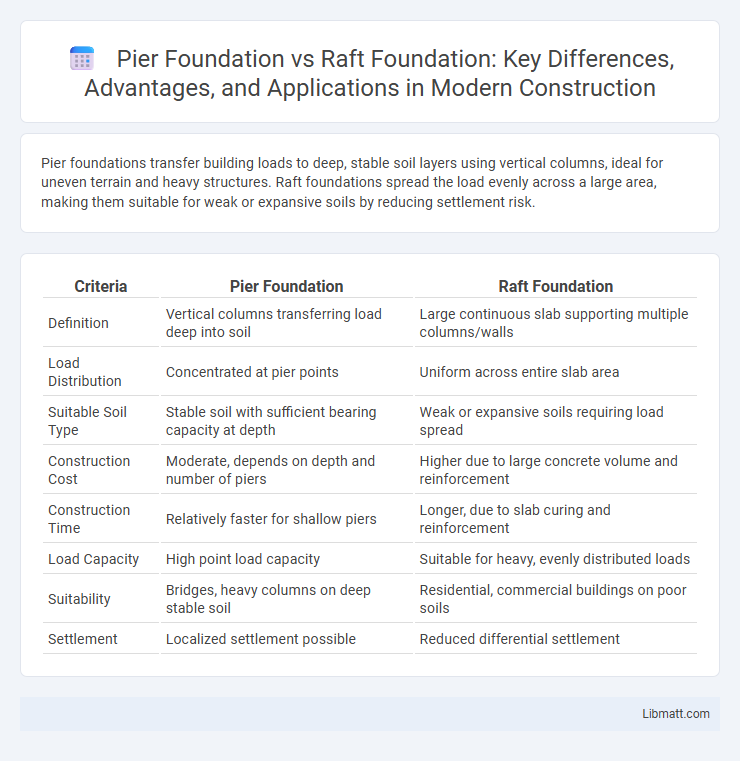Pier foundations transfer building loads to deep, stable soil layers using vertical columns, ideal for uneven terrain and heavy structures. Raft foundations spread the load evenly across a large area, making them suitable for weak or expansive soils by reducing settlement risk.
Table of Comparison
| Criteria | Pier Foundation | Raft Foundation |
|---|---|---|
| Definition | Vertical columns transferring load deep into soil | Large continuous slab supporting multiple columns/walls |
| Load Distribution | Concentrated at pier points | Uniform across entire slab area |
| Suitable Soil Type | Stable soil with sufficient bearing capacity at depth | Weak or expansive soils requiring load spread |
| Construction Cost | Moderate, depends on depth and number of piers | Higher due to large concrete volume and reinforcement |
| Construction Time | Relatively faster for shallow piers | Longer, due to slab curing and reinforcement |
| Load Capacity | High point load capacity | Suitable for heavy, evenly distributed loads |
| Suitability | Bridges, heavy columns on deep stable soil | Residential, commercial buildings on poor soils |
| Settlement | Localized settlement possible | Reduced differential settlement |
Introduction to Pier and Raft Foundations
Pier foundations consist of vertical columns that transfer building loads to deeper, stable soil, making them suitable for uneven or weak surface soils. Raft foundations spread the load across a large slab covering the entire building footprint, ideal for soils with low bearing capacity by distributing weight evenly. You should choose between pier and raft foundations based on soil conditions, load distribution needs, and structural requirements.
Key Differences Between Pier and Raft Foundations
Pier foundations transfer building loads to deeper, more stable soil layers through vertical columns, suitable for structures on uneven or weak soils. Raft foundations spread loads evenly across a large area of soil, providing support for buildings on soft or expansive soils by acting as a continuous slab. Understanding these key differences helps you choose the appropriate foundation type based on soil conditions and load requirements.
Structural Design of Pier Foundations
Pier foundations involve deep vertical load-bearing columns designed to transfer structural loads directly to stable soil or bedrock, providing high load capacity and resistance to settlement in challenging soil conditions. The structural design of pier foundations includes consideration of factors such as pier diameter, depth, reinforcement detailing, and load distribution to ensure stability and durability under axial loads and lateral forces. Compared to raft foundations, which distribute loads over a large area, pier foundations concentrate loads through discrete points, requiring precise geotechnical analysis and structural design to prevent differential settlement and enhance overall foundation performance.
Structural Design of Raft Foundations
Raft foundations distribute structural loads evenly across a large area, minimizing differential settlement and providing stability on weak or expansive soils. Their structural design involves integrating a thick slab with rigid beams or ribs to enhance load-bearing capacity and reduce bending moments. You benefit from a cost-effective, stable base ideal for buildings with heavy loads or poor soil conditions, contrasting with pier foundations that concentrate loads on isolated points.
Suitable Soil Conditions for Each Foundation Type
Pier foundation suits sites with strong, stable soil layers at greater depths, such as dense sand or rock, where loads can be transferred deep below the surface. Raft foundation is ideal for weak or compressible soils, like clay or silt, providing a continuous slab that spreads the load over a large area to prevent excessive settlement. Understanding your soil condition is essential for choosing the appropriate foundation type that ensures structural stability.
Load-Bearing Capabilities: Pier vs Raft
Pier foundations transfer structural loads directly to deep, stable soil layers through individual columns, providing high load-bearing capacity ideal for heavy and concentrated loads. Raft foundations distribute loads over a large area by supporting the entire building footprint on a continuous slab, effectively reducing pressure on weaker soils and suitable for moderate to heavy loads over expansive soil surfaces. Pier foundations excel in conditions requiring minimal soil disturbance, while raft foundations ensure uniform load distribution on less stable, compressible soils.
Advantages of Pier Foundations
Pier foundations offer superior load-bearing capacity, making them ideal for supporting heavy structures and transferring loads to deeper, more stable soil layers. They minimize soil disturbance and reduce excavation costs compared to raft foundations, especially in uneven or sloping terrains. Your project benefits from enhanced stability and reduced settlement risk when using pier foundations in challenging ground conditions.
Benefits of Raft Foundations
Raft foundations provide uniform load distribution across weak or expansive soils, minimizing differential settlement and enhancing structural stability. They reduce excavation costs and construction time compared to pier foundations, especially for large buildings or structures with heavy loads. The continuous base of a raft foundation also improves resistance against soil movement and water infiltration, increasing durability in challenging ground conditions.
Cost Comparison: Pier vs Raft Foundations
Pier foundations generally incur lower initial construction costs due to reduced excavation and material requirements, making them cost-effective for smaller structures or sites with stable soil conditions. Raft foundations, involving extensive concrete slabs covering a large area, tend to have higher upfront expenses but provide better load distribution for weaker or expansive soils, potentially reducing long-term maintenance costs. Overall, the choice between pier and raft foundations hinges on soil characteristics, load demands, and project budget constraints.
Choosing the Right Foundation for Your Project
Choosing the right foundation depends on soil conditions, load requirements, and project scale. Pier foundations are ideal for sites with poor soil bearing capacity and where deep foundations are necessary to transfer loads to stable strata. Raft foundations distribute loads evenly across a large area, making them suitable for weak soils with moderate loads and projects requiring minimal settlement.
Pier foundation vs Raft foundation Infographic

 libmatt.com
libmatt.com